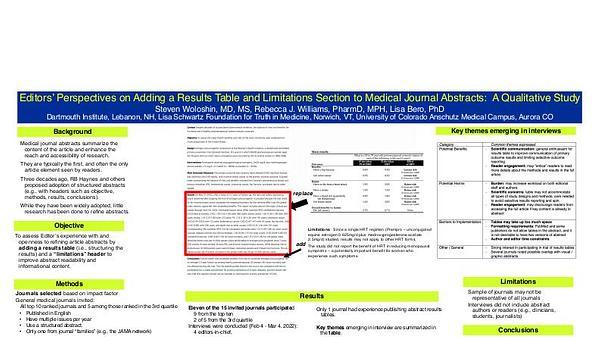Would you like to see your presentation here, made available to a global audience of researchers?
Add your own presentation or have us affordably record your next conference.
keywords:
conflict of interest
ethics and ethical concerns
editorial policies
Objective Recent data suggest that authors may not be transparent with reporting financial conflicts of interest.1,2 However, there is a paucity of data about journal editors,2 who are the ultimate decision-makers regarding publication. This topic is particularly important among specialties with significant academic-industry interactions.
Design A cross-section of the top journals in oncology (100) and cardiology (100) were selected based on their journal impact factors (JIFs).3The JIF and total number of citations for each journal were collated and the primary editors (editor in chief, executive editor, or similar designation) for each journal were identified through journal websites; for journals listing more than a single primary editor (14), each editor was considered separately. Every editor (216) was queried on the Center for Medicare and Medicaid Services Open Payments Database (https://openpaymentsdata.cms.gov) for the most recently reported total payments, general payments, and research payments or associated research funding since 2014. Exclusively international editors (33 for oncology and 45 for cardiology) were not included in analyses. One journal was removed from the oncology data set because of a suspected error in JIF calculation. Payments for each specialty were analyzed using medians and IQRs. Journal websites were examined for editors with more than US $5000 in total payments to assess for transparency.
Results Of 78 editors in oncology, 40 accepted general payments and 24 collected research payments (18 received both); of 60 editors for cardiology, 42 received general payments and 18 received research payments (12 received both). Median general payments were similar between the 2 specialties (Table 55), but research payments were higher for oncology. In journals with editors receiving payments of any type greater than $5000 (54), generic conflict of interest policy statements appeared on 25 journal websites; 3 listed specific dollar amounts or specific companies.

Conclusions Despite increased focus on potential conflicts of interest in journal editing, a significant proportion of editors of top-tier oncology and cardiology journals receive payments from industry, and the nature of these relationships are not transparent to authors or the readership. Given the role that editors play in the publication process, specific conflicts and recusal policies should be more clearly delineated.
References
Baraldi JH, Picozzo SA, Arnold JC, Volarich K, Giofriddo MR, Piper BJ. A cross-sectional examination of conflict-of- interest disclosures of physician-authors publishing in high-impact US medical journals. medRxiv. Preprint posted online January 1, 2022. doi:10.1101/2021.09.12.21263468
Dal-Ré R, Caplan AL, Marusic A. Editors’ and authors’ individual conflicts of interest disclosure and journal transparency: a cross-sectional study of high-impact medical specialty journals. BMJ Open. 2019;9:e029796. doi:10.1136/ bmjopen-2019-029796
Clarivate Analytics. 2020 Journal Impact Factor. Journal Citation Reports. Clarivate; 2021.
Conflict of Interest Disclosures Paul J. Hauptman reported receiving remuneration from Corvia Medical (DSMB), scPharma and LivaNova (clinical events committees), and Array Biopharma (steering committee) for work related to clinical trials as indicated. No other disclosures were reported.


